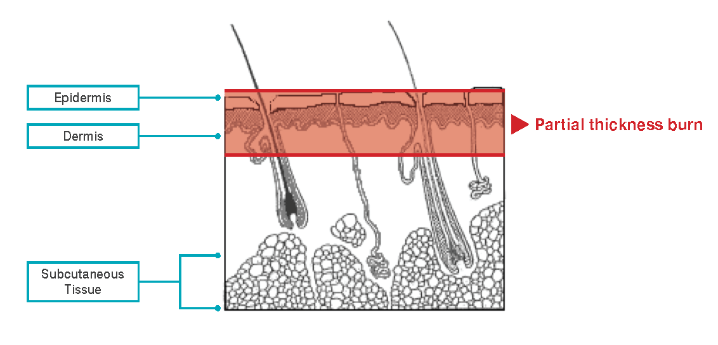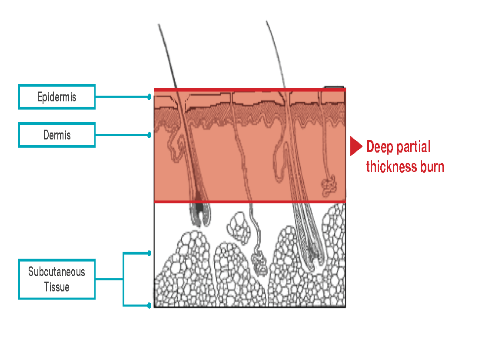Our skin is the body’s largest organ and is critical to survival. It has many functions including:
- moderating temperature
- retaining and maintaining fluid levels in our body
- protecting us from bacteria and infection
- gathering sensory information.
The skin consists of two distinct layers each with their own function the epidermis (outside layer) and the dermis (layer under the dermis).

When you experience a burn caused by extreme heat or cold, contact with electricity, chemicals, friction or radiation, the skin is injured.
Burns are classified depending on the amount of damage done to the different layers of skin and to the structures within these layers. In adults the most prolific burns are caused by flame and in children and young people it is scalds.
Superficial thickness burn Burns affect the outer layer or epidermis. Common symptoms include localised redness and pain.

Assessment of superficial burns
| Appearance | Capillary Refill | Sensation | Healing Time | Scarring |
|---|
| Dry and Red, No Blisters | Blanches | Yes | Within 7 days | No |
Burns affect the second layer of skin or the dermis. Symptoms include blisters, clear fluid emitting from the site and localised pain or with a whitish appearance for a deeper burn and deeper damage. This burn may have limited associated pain due to damage to the blood vessels and nerve endings.

Assessment of partial thickness burns
| Appearance | Capillary Refill | Sensation | Healing Time | Scarring |
|---|
| Pale pink and blisters | Blanches | Very painful | Within 14 days | Colour match defect and low risk of scar |

Assessment of deep partial thickness burns
| Appearance | Capillary Refill | Sensation | Healing Time | Scarring |
|---|
| Dark pink large blisters | Sluggish | Painful | 14 to 21 days | Moderate risk of hypertrophic scarring |
Assessment of full thickness burns
| Appearance | Capillary Refill | Sensation | Healing Time | Scarring |
|---|
| White, leathery Black, charred, no blisters | No | No | No | Yes |
The implications of a burn injury can have a major impact on individuals, their friends and their family.
The severity of a burn determines the treatment and is dependent on several factors including:
- the size and depth
- the location
- the age and general medical condition of the patient
- other injuries.
The acute injury usually requires hospitalisation for fluid resuscitation, pain relief, dressings to control the water loss and reduce the risk of infection, and surgery for wound repair.
Stages of treatment
- Immediate care - The first 48 hours after a burn injury are important for stabilising the burn, cleaning the wound, reducing shock and additional serious complications.
- Closing and healing the wound to reduce infection and encourage tissue regeneration.
- Managing scarring – Using pressure garments and burns creams to improve healing and reduce scarring.
The immediate treatment is all too frequently followed by many years of ongoing treatment to reduce the scarring, improve function and mobility, and deal with possible social and psychological issues.
Rehabilitation can be a long complex road.
The skin loses its ability to stretch, sweat, control its temperature and safely absorb sunlight. This is due to the damage to the skin construct including the sweat glands, hair follicles, nerve endings and melanin profoundly affecting the functionality. This can greatly restrict mobility.
In a young person this is particularly traumatic. As a child grows and develops, the damaged skin will not grow and stretch with the body causing contractures. Ongoing surgery is required to release the skin and graft new skin into the area.
Scarring, especially if visible on the hands, face, neck or arms can greatly affect self-image, resulting in low confidence and low self-esteem. This has the potential to become a barrier to participation in social activities, particularly for young people.
Recent advances have greatly improved treatment options and outcomes. However, these treatments do not yet restore the normal functions to the skin, leading to a potential lifetime of issues.
Burn injuries are notorious for their aggressive scars and, depending on the extent and location of the scar, can affect people who are burnt functionally, cosmetically and psychologically for a lifetime.
What is a scar?
Scars are the result of tissue repair after injury and they are both functionally and aesthetically inferior to normal skin. After injury there is a need to restore the skin barrier quickly to prevent infection. But this repair process comes at a cost – the tissue that is made is not new normal skin but scar. Scar is less flexible than normal skin and looks very different. Scar tissue can also grow – so children that have a scar covering two per cent of the body at two-years-old will have a scar that covers two per cent of the body when they are a 20-year-old.
Whilst scars normally are only the size of the injury, in some people they can develop scars that grow and become larger than the wound. These ‘keloid’ scars need extensive treatment to limit their growth and can be very painful and distressing.
Reasons for scarring
In different tissues of the body, and in different animals, there are levels of capacity to regenerate after an injury. It is well-known for example, that an axolotl can regenerate a whole limb if it is injured. Similarly, we have organs such as the liver that have a very high ability to regenerate. However, in most tissues and organs there is a limit to the ability to regenerate. Once this limit is reached then repair of the damage leads to scar tissue formation. In skin, all but very minor injuries will result in scar formation.
Wound healing
The key driver for our natural healing process is to limit the chance of infection. It is infection that will lead to poor outcomes, and in previous times, death. So our natural response to skin injury is for a rapid repair process that restores the barrier between the body and the environment. As part of this process there is a lot of changes to the structure of the skin being repaired and these changes include loss of flexibility, poor strength and different appearance.
At the Foundation we are continuing to facilitate research to improve the speed and quality of wound healing to reduce scarring (eg spray-on-skin) and better understand how and why scar tissue is formed and maintained over the lifespan. By so doing we hope to find a way to re-program scar cells to aid regenerative repair and return the scar to normal looking skin.
Find out more about our current research.